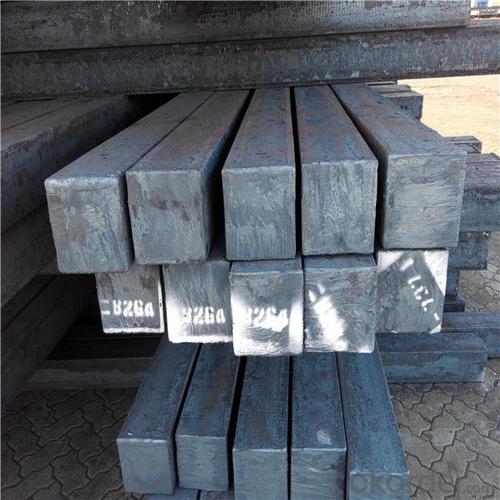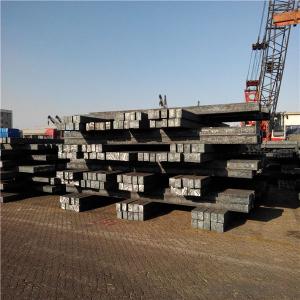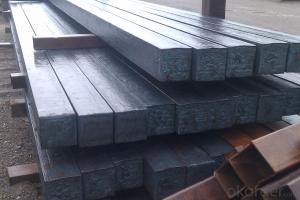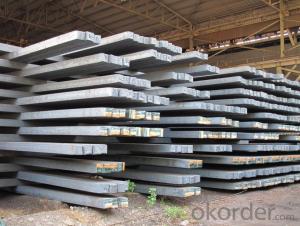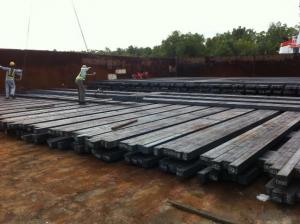Prime concast square steel billet in different size
- Loading Port:
- China main port
- Payment Terms:
- TT OR LC
- Min Order Qty:
- 1000 m.t.
- Supply Capability:
- 18312 m.t./month
OKorder Service Pledge
OKorder Financial Service
You Might Also Like
Specification
Steel billet :
Steel billet(ingot) by cogging or breakdown of semi-finished products, is the raw material of all kinds of steel mill. Billet section of square, round, flat,
rectangular and abnormity of several kinds of, mainly related to the shape of rolled products.
The billet is mainly divided into two kinds from the shape:
Slab: cross section width and height of the ratio of the larger, mainly used for rolling plate.
Billet: equal cross section width and height, or a huge difference, mainly used for rolling steel, wire rod. ,
Gade:
Standard | C(%) | Mn(%) | S(%) | P(%) | Si(%) |
Q195 | ≤0.12 | ≤0.50 | ≤0.040 | ≤0.035 | ≤0.30 |
Q235 | ≤0.20 | ≤1.40 | ≤0.045 | ≤0.045 | ≤0.35 |
Q275 | ≤0.22 | ≤1.50 | ≤0.045 | ≤0.045 | ≤0.35 |
20MnSi | 0.17-0.25 | 1.2-1.6 | ≤ 0.050 | ≤ 0.050 | 0.40-0.80 |
3SP | 0.14-0.22 | 0.40-0.85 | ≤ 0.050 | ≤ 0.040 | 0.05-0.15 |
5SP | 0.28-0.37 | 0.50-1.00 | ≤ 0.050 | ≤ 0.040 | 0.15-0.30 |
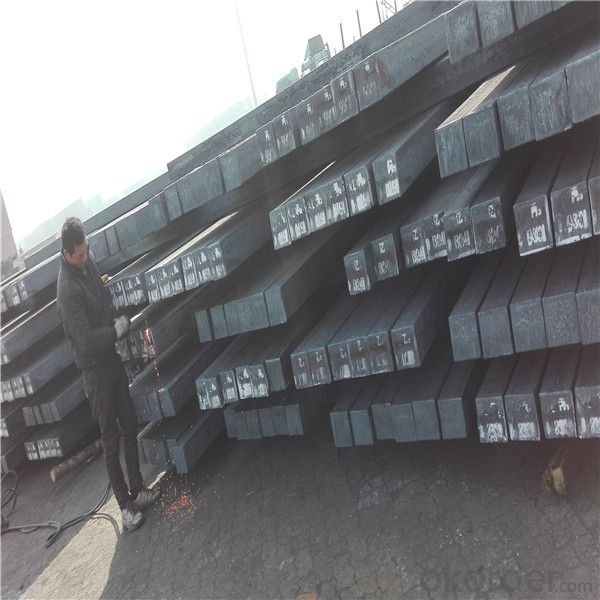
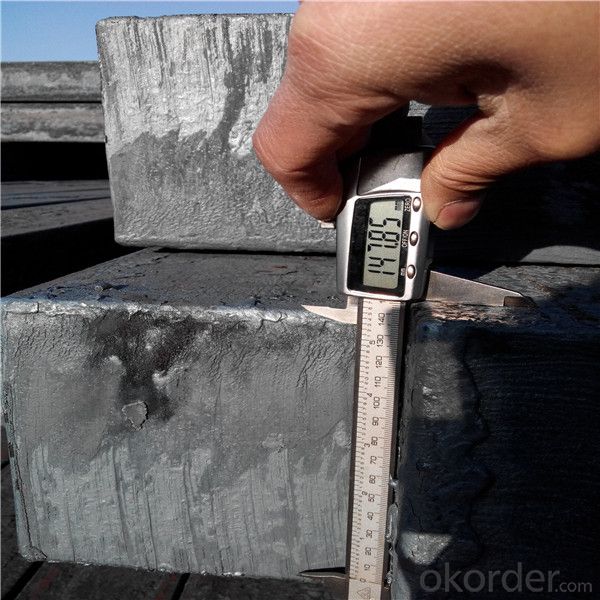
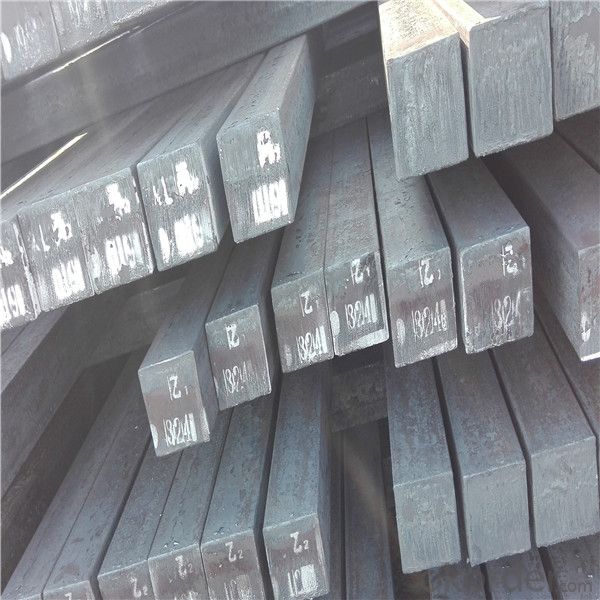
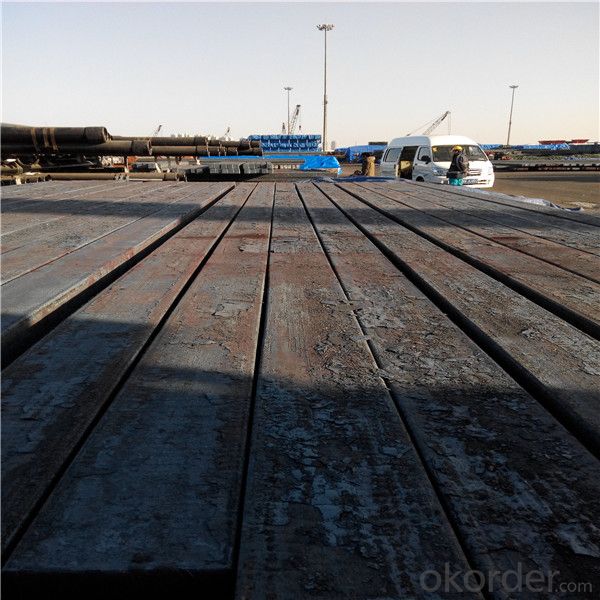
Our Advantage
* Professional Personnel of Steel Trading
* Strong Steel Industry Background
* Conveniently Geographic Location
Our Commitment
* Sincere, Practical, Efficient and Developing
* High Quality Steel Production
* Competitive Price and Timely Delivery
Packing :
Within 30 days
1.Standard export package
2.In bundles with steel strips
3.As the requirements of the customers
FAQ:
Q: How to get quotation?
A: When we receive your detailed enquiry, we will set the best price based on standard,
steel grade, outer diameter, wall thickness, quantity, country.
And we will send quotation to your mailbox.
Q:How to guarantee the quality of the products?
A:We have established the international advanced quality management system,every link from raw material
to final product we have strict quality test;We resolutely put an end to unqualified products flowing into the market.
At the same time, we will provide necessary follow-up service assurance.
Q:How long can we receive the product after purchase?
A :In the purchase of product within three working days, We will arrange the factory delivery as soon as possible.
The pecific time of receiving is related to the state and position of customers.
- Q: How are steel billets recycled or reused?
- Various methods can be employed to recycle or reuse steel billets, which are semi-finished metal products. One commonly used method is electric arc furnace (EAF) steelmaking, where the billets are melted down in an electric arc furnace and utilized in the production of new steel products. This process effectively utilizes resources and aids in the reduction of greenhouse gas emissions and energy consumption compared to primary steel production. Steel billets can also be repurposed in industries like construction, automotive, and manufacturing. They can be transformed and reconfigured to create novel steel products or utilized as raw material for forging, rolling, or extrusion processes. By reusing steel billets, the industry can alleviate the demand for newly manufactured steel and conserve natural resources. Moreover, steel billets can be recycled through continuous casting. In this technique, the molten steel is poured into a continuous casting machine, resulting in the formation of solid billets. These billets can then undergo hot or cold rolling processes to produce various steel products such as bars, rods, or wire. Furthermore, steel billets can be melted and recast into different forms via remelting. Technologies like induction melting or vacuum arc remelting can be employed to purify the steel and achieve desired chemical and mechanical properties. Remelting facilitates the production of high-quality steel billets suitable for specialized applications in industries such as aerospace, defense, or medical sectors. In conclusion, steel billets are effectively recycled or reused through processes like electric arc furnace steelmaking, continuous casting, remelting, and reshaping. These methods not only contribute to the sustainability of the steel industry but also aid in resource conservation, emission reduction, and meeting the rising demand for steel products.
- Q: What are the main factors that affect the availability of steel billets?
- The availability of steel billets is affected by various key factors. First and foremost, the availability of raw materials plays a critical role. Steel billets are produced by melting iron ore, alongside other materials like coal and limestone, in a blast furnace. The production of steel billets can be greatly influenced by the availability and cost of these raw materials. Any disruptions in the supply chain, such as a shortage of iron ore or a sudden increase in prices, can result in a decrease in the availability of steel billets. Additionally, the demand for steel billets also impacts their availability. The construction and manufacturing industries are the primary consumers of steel billets, as they use them to manufacture various steel products like bars, rods, and beams. If there is a surge in demand for steel products, it can strain the availability of steel billets, particularly if the production capacity is unable to keep pace with the increased demand. Moreover, market dynamics and economic conditions can have an effect on the availability of steel billets. Factors like fluctuations in steel prices, changes in government policies, and trade barriers can influence the overall supply and demand balance. For instance, the implementation of tariffs or restrictions on steel imports can reduce the availability of steel billets in a specific region, as domestic production may not be sufficient to meet the demand. Furthermore, technological advancements and production capabilities also contribute to determining the availability of steel billets. Enhancements in manufacturing processes, such as the utilization of electric arc furnaces or continuous casting, can enhance production efficiency and output. Conversely, any technical issues or maintenance problems in steel plants can disrupt production and subsequently decrease the availability of steel billets. In conclusion, the availability of steel billets is influenced by factors such as the availability and cost of raw materials, the demand for steel products, market dynamics, economic conditions, and technological advancements. These factors, either individually or collectively, can impact the availability of steel billets. It is crucial for stakeholders in the steel industry to monitor and address these factors in order to ensure a stable supply of steel billets.
- Q: What is the drop per minute of the billet temperature at 850?
- Cold rolling is not considered. The initial rolling temperature (surface) of the billet is generally 1000-1150 degrees.
- Q: Is there an export duty? Or is there a tax refund?
- Your specification 13*13*6 or 12 meters, this is a square cross section, so 7207120000 this can not be used, your billet carbon content is 0.17 to 0.23% less than 0.25%, so we must use the following7207190000 Other Billets with carbon content less than 0.25%Export tax refund: 0%MFN country of import tariff: 2%General customs duties: 11%Export tariff rate: 0%VAT: 17%
- Q: What are the different methods of steel billet surface cleaning?
- There are several methods of steel billet surface cleaning, each with its own advantages and disadvantages. Some of the common methods include: 1. Shot Blasting: This method involves shooting small metallic or non-metallic particles at high velocity onto the surface of the billet. The impact of these particles removes any rust, scale, or surface contaminants. Shot blasting is an effective method for cleaning large surfaces quickly, but it can cause surface roughness and may not be suitable for all types of steel. 2. Acid Pickling: Acid pickling involves immersing the steel billet in an acid solution, typically hydrochloric or sulfuric acid, to remove scale and rust. The acid reacts with the surface contaminants, dissolving them and leaving a clean surface. Acid pickling is effective in removing stubborn scale and rust, but it requires careful handling of the corrosive acids and proper disposal of the waste. 3. Mechanical Cleaning: Mechanical cleaning methods involve using abrasive tools or brushes to physically scrub the surface of the billet. This can be done manually or using machinery. Mechanical cleaning is effective in removing loose contaminants and scale, but it may not be suitable for heavily rusted or stubbornly adhered contaminants. 4. High-Pressure Water Jetting: This method uses high-pressure water jets to clean the surface of the billet. The force of the water removes scale, rust, and other contaminants. High-pressure water jetting is environmentally friendly as it does not involve the use of chemicals, but it may not be as effective in removing heavy scale or rust. 5. Ultrasonic Cleaning: Ultrasonic cleaning involves immersing the steel billet in a tank filled with a cleaning solution and subjecting it to high-frequency ultrasonic vibrations. The vibrations create tiny bubbles in the cleaning solution, which implode on the surface of the billet, effectively removing contaminants. Ultrasonic cleaning is effective in removing even microscopic particles and can reach complex geometries, but it may not be suitable for large-scale cleaning operations. Each of these methods has its own strengths and limitations, and the choice of method depends on factors such as the type and condition of the surface contaminants, the time and cost constraints, and the desired surface finish.
- Q: What are the potential defects or flaws in steel billets?
- There are several potential defects or flaws that can occur in steel billets, which can affect the quality and performance of the final product. Some of these defects include: 1. Surface defects: Steel billets can develop surface cracks, scales, or scratches during the manufacturing process. These defects can weaken the material and reduce its structural integrity. 2. Internal defects: Inclusions, such as non-metallic impurities or gas bubbles, can be present within the steel billets. These internal defects can cause localized weaknesses and reduce the overall strength of the material. 3. Segregation: Uneven distribution of alloying elements or impurities can lead to segregation, where certain areas of the billet have different chemical compositions. Segregation can result in inconsistent mechanical properties across the material and decrease its uniformity. 4. Central segregation: This defect occurs when there is a concentration of impurities or alloying elements in the central region of the billet, leading to a weaker core. Central segregation can cause structural failures and reduce the overall reliability of the steel billet. 5. Shrinkage cavities: During the solidification process, shrinkage cavities can form in the steel billet due to the contraction of the molten metal. These cavities can weaken the material and compromise its structural integrity. 6. Surface decarburization: Exposure to high temperatures or improper heat treatment can cause the surface of the steel billet to lose carbon content, resulting in surface decarburization. This defect can reduce the hardness and strength of the material. 7. Laminations: Laminations are thin, elongated voids or layers that can form parallel to the surface of the billet. These defects can weaken the material and make it prone to cracking or failure under stress. 8. Internal cracks: Internal cracks can occur due to improper cooling or handling of the billet during the manufacturing process. These cracks can compromise the structural integrity of the steel billet and potentially lead to catastrophic failure. It is important to detect and address these defects early on to ensure the quality and reliability of the steel billets. Various non-destructive testing techniques, such as ultrasonic testing or magnetic particle inspection, can be utilized to identify and mitigate these potential flaws.
- Q: What are the common surface defects in steel billets during cooling?
- Common surface defects in steel billets during cooling include cracks, surface scaling or oxidation, and surface decarburization.
- Q: Can steel billets be used in the production of bicycles?
- Certainly! Bicycles can indeed utilize steel billets in their production. Steel billets, which are partially finished products derived from steel, can undergo further processing to attain a wide range of shapes and sizes. When it comes to bicycles, these steel billets can be molded and fashioned into diverse components such as frames, forks, handlebars, and other structural elements. Steel remains a popular choice for bicycle production due to its commendable attributes of strength, durability, and cost-effectiveness. It offers exceptional rigidity, stability, and resistance to deformation, rendering it suitable for various bicycle types including road bikes, mountain bikes, and hybrid bikes. Furthermore, steel can be readily welded, enabling customization and facilitating the repair of bicycle frames.
- Q: What are the different grades of steel billets?
- There are several different grades of steel billets, including low carbon steel, medium carbon steel, high carbon steel, alloy steel, and stainless steel. The specific grade of steel billet used depends on the intended application and desired properties of the final product.
- Q: What is the maximum length of a steel billet?
- The maximum length of a steel billet can vary depending on various factors such as the production process, equipment capabilities, and industry standards. However, in general, steel billets are commonly produced with lengths ranging from a few meters to around 12 meters.
Send your message to us
Prime concast square steel billet in different size
- Loading Port:
- China main port
- Payment Terms:
- TT OR LC
- Min Order Qty:
- 1000 m.t.
- Supply Capability:
- 18312 m.t./month
OKorder Service Pledge
OKorder Financial Service
Similar products
Hot products
Hot Searches
Related keywords


